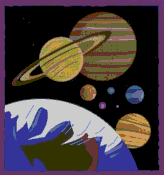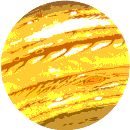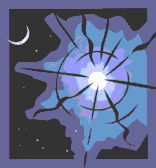Lessons From Other Worlds
 In the past 25 years
mankind has been able to use technology to
examine areas of the cosmos far removed from our own solar system. New
optical systems, new sensing systems, and a variety of telescopes in
orbit around Earth using X rays, infrared, ultraviolet as well as
visible light have greatly influenced our ability to detect other
objects in the cosmos. One of the things that has been studied in
considerable depth is the presence of other solar systems--planets
orbiting other stars. As of August 2004, science has identified 107
solar systems and 120 planets. Robert Zimmerman writing in Astronomy (August 2004, pages
43-47) says "Of the 107 known solar systems, not one resembles our own,
even approximately."
In the past 25 years
mankind has been able to use technology to
examine areas of the cosmos far removed from our own solar system. New
optical systems, new sensing systems, and a variety of telescopes in
orbit around Earth using X rays, infrared, ultraviolet as well as
visible light have greatly influenced our ability to detect other
objects in the cosmos. One of the things that has been studied in
considerable depth is the presence of other solar systems--planets
orbiting other stars. As of August 2004, science has identified 107
solar systems and 120 planets. Robert Zimmerman writing in Astronomy (August 2004, pages
43-47) says "Of the 107 known solar systems, not one resembles our own,
even approximately."
 The very fact that
these other systems are so much different than
ours has some things to tell us, and in fact the more we study these
other systems the more we learn about our own system and why things are
the way they are. One of the interesting facts about other systems is
that even though some planets are very large and obviously gaseous,
they can exist very close to their stars. It used to be that
astronomers explained the inner planets of our own solar system being
rocky and hard by saying that the Sun burned off the gases and left the
rocky material. That may in fact be partially true, but recently an
object named OGLE-TR-56b was discovered that is about the same mass as
Jupiter but is over 30 percent larger. It would have to be a gaseous
object to have such a low density, but it is orbiting its star at an
average distance of only 2 million miles--much closer than Mercury is
to the Sun (Mercury is 36 million miles away from the Sun). The outer
atmosphere of this planet must be around 3000°F. We do not know
what the chemical composition of this planet is, but it is obvious that
gaseous planets can exist very close to their stars, and our old
explanation of the inner planets in our own solar system is vastly
oversimplified.
The very fact that
these other systems are so much different than
ours has some things to tell us, and in fact the more we study these
other systems the more we learn about our own system and why things are
the way they are. One of the interesting facts about other systems is
that even though some planets are very large and obviously gaseous,
they can exist very close to their stars. It used to be that
astronomers explained the inner planets of our own solar system being
rocky and hard by saying that the Sun burned off the gases and left the
rocky material. That may in fact be partially true, but recently an
object named OGLE-TR-56b was discovered that is about the same mass as
Jupiter but is over 30 percent larger. It would have to be a gaseous
object to have such a low density, but it is orbiting its star at an
average distance of only 2 million miles--much closer than Mercury is
to the Sun (Mercury is 36 million miles away from the Sun). The outer
atmosphere of this planet must be around 3000°F. We do not know
what the chemical composition of this planet is, but it is obvious that
gaseous planets can exist very close to their stars, and our old
explanation of the inner planets in our own solar system is vastly
oversimplified.
Most of the planets we see around other stars are very large. That
is not too surprising as it is obviously easier to see a big planet
than it is a small one. One planet has been seen which is 17 times as
massive as Jupiter. The strange thing is that a large number of these
planets are closer to the Sun than Venus. Old theories of planet
formation suggested that due to the large gravity values of stars, it
was impossible for planets to form close to the stars. We now know that
is not true.
Science programs on television have delighted in proposing that the
cosmos is full of planets and that every galaxy has literally millions
of planets. The hope is that if you have enough planets the chance of
having another Earth is improved. We now know that many galactic
systems do not have planets at all. In 1999 the Hubble Space Telescope
surveyed globular cluster 47 Tucanae looking for planets; 34,000 stars
were examined and no planets were found. The composition and age of
galactic systems obviously have a major impact on whether planets can
exist or not, but claims of billions and billions of planets in the
cosmos are obviously an exaggeration.
 The type of star
that we are considering also has an impact on
whether planetary systems can form or not. Planets have been found
orbiting pulsars, binary stars, and spectral classes of stars like our
Sun. Most stars in the cosmos are binary systems containing more than
one star. A planet can orbit the stars at a great distance, but
shifting gravity fields make planets unlikely if the stars are close
together as most are. We now know that how much metal there is in a
star system has an effect on planet formation. Metal content varies
within galaxies as well as between stars, so a part of space dominated
by gases like hydrogen and helium are not as likely to produce planets
as areas where there are large amounts of iron, manganese, cobalt, and
the like.
The type of star
that we are considering also has an impact on
whether planetary systems can form or not. Planets have been found
orbiting pulsars, binary stars, and spectral classes of stars like our
Sun. Most stars in the cosmos are binary systems containing more than
one star. A planet can orbit the stars at a great distance, but
shifting gravity fields make planets unlikely if the stars are close
together as most are. We now know that how much metal there is in a
star system has an effect on planet formation. Metal content varies
within galaxies as well as between stars, so a part of space dominated
by gases like hydrogen and helium are not as likely to produce planets
as areas where there are large amounts of iron, manganese, cobalt, and
the like.
Perhaps one of the most interesting lessons we have learned from
other solar systems has been that the shape of the orbits of the
objects in our solar system is very unusual. Most planets in our solar
system have a very circular orbit. What that means is that their
distance from the Sun does not vary a great deal. Venus has an orbit
that is .007 with 0 being a perfect circle and a straight line being 1.
Pluto has the most elliptical orbit, but even Pluto is less than .3 on
the scale above. Circular orbits like ours have been almost nonexistent
in other solar systems. In other solar systems .7 is a very common
orbital value and virtually all orbits exceed .3. If a planet swings
way out away from its star and then comes within 2 million miles after
having been many million miles away, it should be obvious that
temperature conditions are going to be extreme. Not only will such a
planet have extreme conditions itself, but it will have a very negative
effect on any planets that do have a circular orbit in the system. If
Jupiter came closer to the Sun than Earth every time it orbited,
imagine what the conditions would be on Earth as Jupiter went by us.
We now know that our giant planets (Jupiter, Saturn, Uranus, and
Neptune) are important to us because their gravitational fields sweep
up any debris floating in space. Without these objects, comets and
asteroids would pound Earth and life here would be difficult if not
impossible. The fact that they are outside Earth's orbit at a
considerable distance and in a circular orbit allows us to exist in a
stable condition for extensive lengths of time. The comets that do come
into our system do not come in along the plane of the solar system
called the ecliptic, because the giant planets swallow them up. The
ones that come in from other directions have no chance of hitting Earth
since they are not in the plane of the Earth's orbit around the Sun.
The Hale-Bopp comet was beautiful, but it posed no danger to us here on
Earth.
Like everything in science, the study of the cosmos and of other
solar systems speaks eloquently to us about the design and planning
that has been a part of everything in the creation. As more data is
discovered other lessons will come that will tell us how special and
how well designed our home is. It also should impress upon us the
importance of following God's instructions to take care of the
Garden--dress it and keep it (Genesis 2:15).
In the twenty-first century we have more of a reason than any humans
have ever had to repeat the old Psalmist message "The heavens declare
the glory of God, and the firmament showeth His handiwork" (Psalm 19:1)
--John
N. Clayton
Back to Contents
Does God Exist?, MarApr05.
 In the past 25 years
mankind has been able to use technology to
examine areas of the cosmos far removed from our own solar system. New
optical systems, new sensing systems, and a variety of telescopes in
orbit around Earth using X rays, infrared, ultraviolet as well as
visible light have greatly influenced our ability to detect other
objects in the cosmos. One of the things that has been studied in
considerable depth is the presence of other solar systems--planets
orbiting other stars. As of August 2004, science has identified 107
solar systems and 120 planets. Robert Zimmerman writing in Astronomy (August 2004, pages
43-47) says "Of the 107 known solar systems, not one resembles our own,
even approximately."
In the past 25 years
mankind has been able to use technology to
examine areas of the cosmos far removed from our own solar system. New
optical systems, new sensing systems, and a variety of telescopes in
orbit around Earth using X rays, infrared, ultraviolet as well as
visible light have greatly influenced our ability to detect other
objects in the cosmos. One of the things that has been studied in
considerable depth is the presence of other solar systems--planets
orbiting other stars. As of August 2004, science has identified 107
solar systems and 120 planets. Robert Zimmerman writing in Astronomy (August 2004, pages
43-47) says "Of the 107 known solar systems, not one resembles our own,
even approximately." The very fact that
these other systems are so much different than
ours has some things to tell us, and in fact the more we study these
other systems the more we learn about our own system and why things are
the way they are. One of the interesting facts about other systems is
that even though some planets are very large and obviously gaseous,
they can exist very close to their stars. It used to be that
astronomers explained the inner planets of our own solar system being
rocky and hard by saying that the Sun burned off the gases and left the
rocky material. That may in fact be partially true, but recently an
object named OGLE-TR-56b was discovered that is about the same mass as
Jupiter but is over 30 percent larger. It would have to be a gaseous
object to have such a low density, but it is orbiting its star at an
average distance of only 2 million miles--much closer than Mercury is
to the Sun (Mercury is 36 million miles away from the Sun). The outer
atmosphere of this planet must be around 3000°F. We do not know
what the chemical composition of this planet is, but it is obvious that
gaseous planets can exist very close to their stars, and our old
explanation of the inner planets in our own solar system is vastly
oversimplified.
The very fact that
these other systems are so much different than
ours has some things to tell us, and in fact the more we study these
other systems the more we learn about our own system and why things are
the way they are. One of the interesting facts about other systems is
that even though some planets are very large and obviously gaseous,
they can exist very close to their stars. It used to be that
astronomers explained the inner planets of our own solar system being
rocky and hard by saying that the Sun burned off the gases and left the
rocky material. That may in fact be partially true, but recently an
object named OGLE-TR-56b was discovered that is about the same mass as
Jupiter but is over 30 percent larger. It would have to be a gaseous
object to have such a low density, but it is orbiting its star at an
average distance of only 2 million miles--much closer than Mercury is
to the Sun (Mercury is 36 million miles away from the Sun). The outer
atmosphere of this planet must be around 3000°F. We do not know
what the chemical composition of this planet is, but it is obvious that
gaseous planets can exist very close to their stars, and our old
explanation of the inner planets in our own solar system is vastly
oversimplified.  The type of star
that we are considering also has an impact on
whether planetary systems can form or not. Planets have been found
orbiting pulsars, binary stars, and spectral classes of stars like our
Sun. Most stars in the cosmos are binary systems containing more than
one star. A planet can orbit the stars at a great distance, but
shifting gravity fields make planets unlikely if the stars are close
together as most are. We now know that how much metal there is in a
star system has an effect on planet formation. Metal content varies
within galaxies as well as between stars, so a part of space dominated
by gases like hydrogen and helium are not as likely to produce planets
as areas where there are large amounts of iron, manganese, cobalt, and
the like.
The type of star
that we are considering also has an impact on
whether planetary systems can form or not. Planets have been found
orbiting pulsars, binary stars, and spectral classes of stars like our
Sun. Most stars in the cosmos are binary systems containing more than
one star. A planet can orbit the stars at a great distance, but
shifting gravity fields make planets unlikely if the stars are close
together as most are. We now know that how much metal there is in a
star system has an effect on planet formation. Metal content varies
within galaxies as well as between stars, so a part of space dominated
by gases like hydrogen and helium are not as likely to produce planets
as areas where there are large amounts of iron, manganese, cobalt, and
the like.